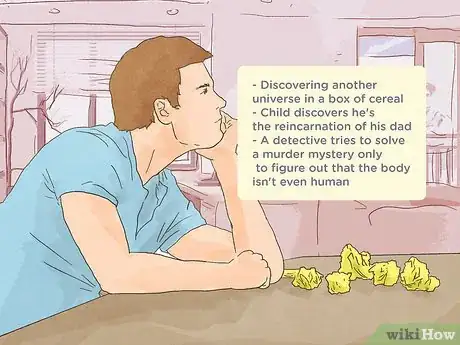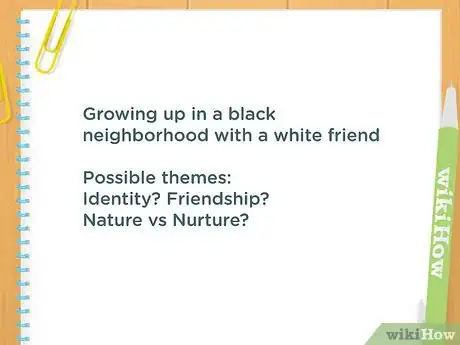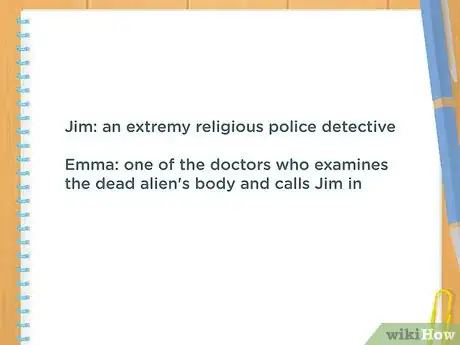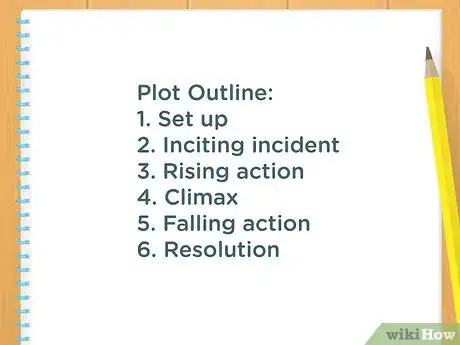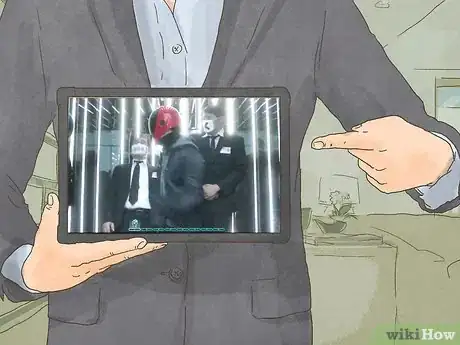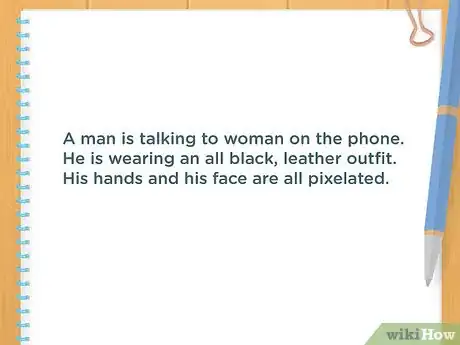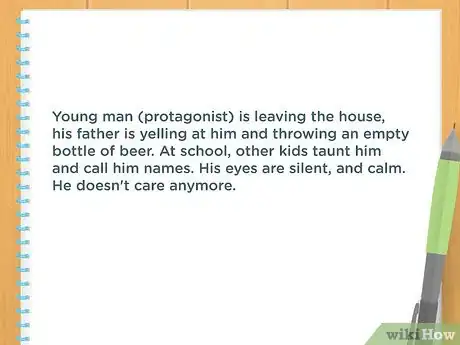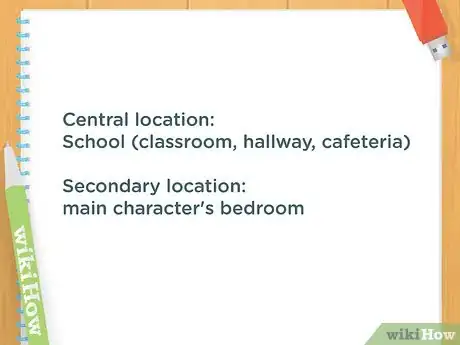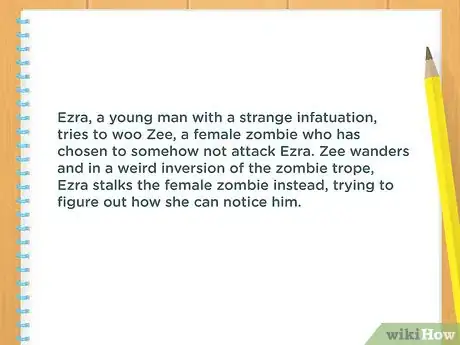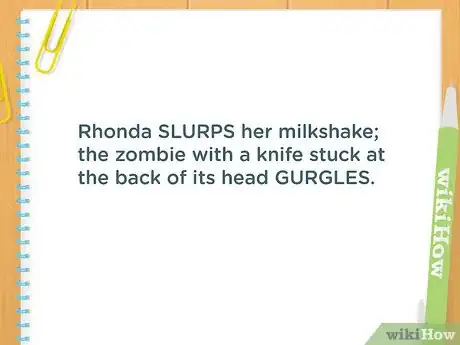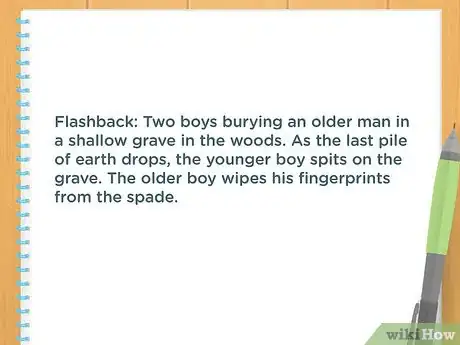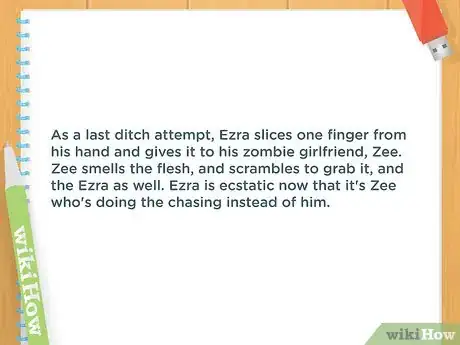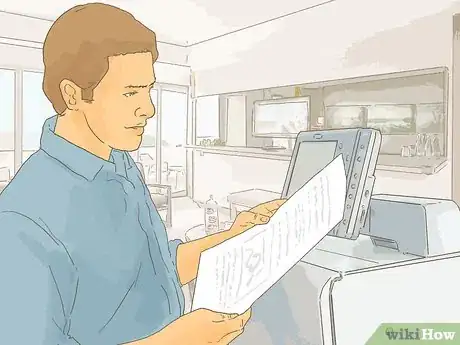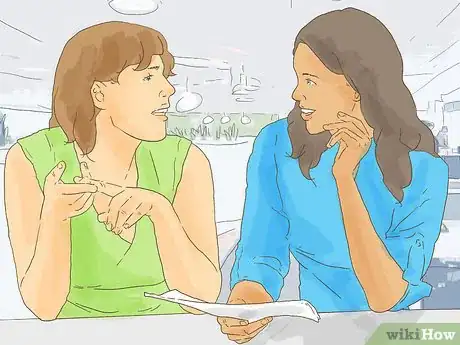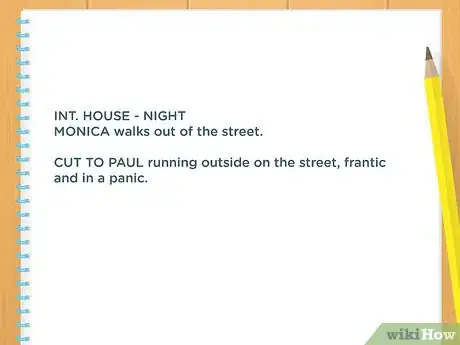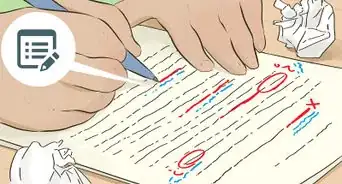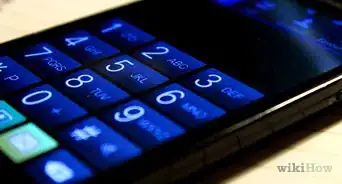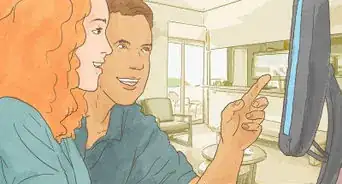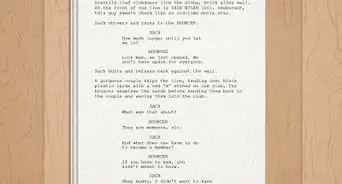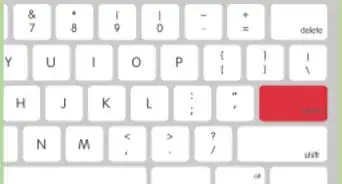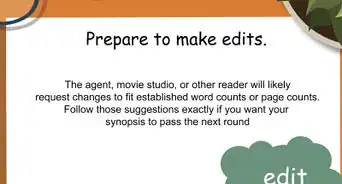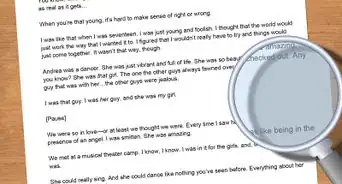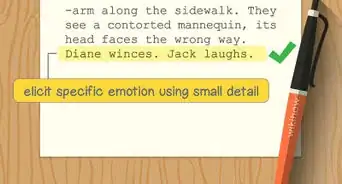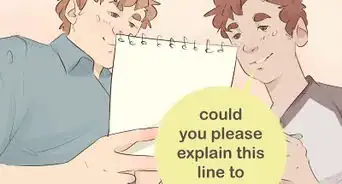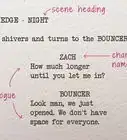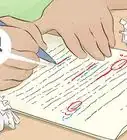This article was co-authored by Melessa Sargent. Melessa Sargent is the President of Scriptwriters Network, a non-profit organization that brings in entertainment professionals to teach the art and business of script writing for TV, features and new media. The Network serves its members by providing educational programming, developing access and opportunity through alliances with industry professionals, and furthering the cause and quality of writing in the entertainment industry. Under Melessa's leadership, SWN has won numbers awards including the Los Angeles Award from 2014 through 2021, and the Innovation & Excellence award in 2020.
There are 9 references cited in this article, which can be found at the bottom of the page.
wikiHow marks an article as reader-approved once it receives enough positive feedback. This article received 31 testimonials and 88% of readers who voted found it helpful, earning it our reader-approved status.
This article has been viewed 573,033 times.
Short films are a great way to get started in your film career. A good short film can help you develop your style and vision for a feature film. One of the most important aspects of a short film is a screenplay that is engaging for your viewers. Start by brainstorming ideas, concepts, and characters for your film. Then, draft a script that grabs readers with action and cool characters right away. Make sure you polish your draft and get feedback on it so the script is at its best before you shoot it or try to get it made.
Steps
Brainstorming Ideas
-
1Come up with a unique concept for the film. Make the concept feel exaggerated or bigger than real life. Take an ordinary thing in real life and make it strange. Use a memorable experience from your childhood or a strange story from the news as inspiration for your short film.[1]
- For example, maybe you use a childhood memory of going to the dentist as inspiration, where the dentist is actually a serial killer with a drill.
- You can also try taking a familiar film concept, such as someone finding a dead body on the beach, and make it strange. For example, maybe the person finds a dead alien on the beach.
-
2Focus on a particular theme. You can also use a theme as inspiration, such as “identity,” “loss,” or “friendship.” Put your own particular spin on the theme so it feels fresh and new in your short film.[2]
- For example, you may focus on a theme like “identity” by thinking about your parents’ experiences growing up poor and Black in a bad neighborhood. Or you may focus on a theme like “friendship” by thinking about a friendship between a young person and an older person.
Advertisement -
3Have a compelling main character. Many short films focus on just one main character, as this allows the film to explore the character in a short amount of time. Create a main character that will interesting to your viewers. Avoid stereotypes or cliches. Instead, make the main character relatable and unique.[3]
- For example, you may have a main character who is a young boy struggling to succeed in high school and deal with an alcoholic father. Or you may have a main character who is an alien trying to find their way back to their home planet.
-
4Make a plot outline. A plot outline consists of six parts: the set up, the inciting incident, the rising action, the climax, the falling action, and the resolution. A short film should have all of these elements. An example plot outline may look like:[4]
- Set up: This is where you outline the setting, the protagonist, and their conflict. For example, a young boy struggles to fit in at school and deal with an alcoholic father at home.
- Inciting incident: This is an event that changes the course of the protagonist’s life. For example, the young boy meets his new neighbor, an older boy who is a senior at his high school.
- Rising action: This is where you develop your characters and their relationships. For example, the two boys bond by hanging out in their neighborhood. They become best friends.
- Climax: This is the high point, where the most drama occurs. For example, the alcoholic father confronts the older boy, and they get in a physical fight.
- Falling action: This is where your protagonist deals with the climax. For example, the younger boy kills his father to save the older boy.
- Resolution: This is where your protagonist resolves their conflict and succeeds or fails in getting what they want. For example, the boys bury the father’s body and swear to tell no one what happened.
-
5Watch examples of short films. Get a better sense of what makes a successful short film by watching a few examples. Look at short films in a variety of genres, from horror to rom-com to coming-of-age. Notice how they develop character and story in a short period of time. You may watch:EXPERT TIPMelessa Sargent is the President of Scriptwriters Network, a non-profit organization that brings in entertainment professionals to teach the art and business of script writing for TV, features and new media. The Network serves its members by providing educational programming, developing access and opportunity through alliances with industry professionals, and furthering the cause and quality of writing in the entertainment industry. Under Melessa's leadership, SWN has won numbers awards including the Los Angeles Award from 2014 through 2021, and the Innovation & Excellence award in 2020.Professional Writer

 Melessa Sargent
Melessa Sargent
Professional WriterConsider watching cartoons for inspiration. Cartoon shows are really great for short film inspiration because they have to tell a whole story in about 15 to 20 minutes. Watch a couple (or more!) and see what they have in common in terms of plot structure, character development, and pacing.
Creating a Draft
-
1Begin with action and character. Start the short film with a strong image that piques the viewer’s interest. You want to capture them in the first 20 seconds of the film. You may show the character in action, doing something mysterious or intense. You may also have engaging dialogue and imagery.[9]
- For example, you may start your short film with a shot of the alien crash landing onto a beach next to a family who is sunbathing. This is an interesting image that will make the viewer wonder what happens next.
-
2Establish the story early. Provide the set up for the short film within the first one to two minutes. Give the viewer enough information about the main character and their conflict early on so they continue watching.[10]
- For example, you open with a scene involving the main character leaving the house and going to school. You may show them dealing with their alcoholic father and with bullies at school to establish the conflict.
-
3Have a limited number of locations and characters. Keep the screenplay short and effective by only having one to three characters. Stick to one to three locations. This will ensure you do not have to budget for a lot of locations or actors. It will also help to keep the screenplay tight and focused.[11]
- For example, you may have one central location, like a high school, and a secondary location, like your main character’s bedroom.
- You may also have only one main character, with one or two secondary characters. Or you may have two main characters and no secondary characters at all.
-
4Write with a genre in mind. Short films tend to be more successful if they focus on a particular genre, such as horror, thriller, rom-com, or coming-of-age. Pick a genre that you find inspiring and make it your own. Include familiar images found in the genre and a few unique ones too.[12]
- For example, you may write a horror short film where the main character is in love with a zombie during a zombie apocalypse. Or you may write a coming-of-age short film where the main character bonds with a young alien who has crash landed on the beach.
-
5Focus on strong visuals. Remember that film is a visual medium. Use this to your advantage to keep the viewer engaged. Include visuals that are interesting or stunning. Describe visuals that help to build character and create a tone to the film.[13]
- For example, you describe a setting as "a busy day at the beach, with families playing in the sand by the shore." Or you may describe a person as "a green alien wearing a fanny pack."
-
6Include sounds in the script. Notate any sounds or noises in the script using ALL CAPS. This will make your scenes seem more sensory.
- For example, you may write, “Rhonda SLURPS her milkshake” or “The zombie GURGLES in bed.”
-
7Keep the dialogue short and impactful. Because you have limited time in your short film, do not have dialogue that is long-winded or overly descriptive. Stick to dialogue that adds to your characters and keeps the story moving forward. Try for dialogue that is three lines or less. Often in a short film, less dialogue and strong visuals are key.[14]
- For example, you may have a main character who is shy and only communicates with one word answers. Or you may have a main character who only speaks to their pet turtle and is silent around other characters, communicating instead through action.
-
8Experiment with structure and time. A short film is a great chance for you to play with how you order the sequence of events in the story. Try starting at the end and working your way back to the beginning. Consider having flashbacks in the short film so you can jump around in time.[15]
- For example, you may start with a scene showing two boys burying an older man in a grave in the woods. You may then work backwards to show how they got there.
- Make sure your structure is not confusing or unclear to viewers. Your experimentation should never come at the expense of the story. It should add to the story, rather than distract from it.
-
9Have a clever or surprising ending. Most short films are effective if they have an ending that is memorable for viewers. Often, the ending is surprising or puts a clever twist on what the viewer thinks they know. Try to write an ending that will shock or surprise your viewer, rather than an ending that simply resolves conflict or feels predictable.[16]
- For example, you may have an ending where it turns out the mother paid the older boy to help the younger boy kill his father.
Polishing the Draft
-
1Read the draft aloud. This will help you check that the dialogue sounds natural and engaging. It can also help you check that the scenes flow well.
- You can also do a live read through of the script to help polish it. Ask friends to play certain characters and voice the dialogue. Have actors come in and voice the dialogue to see how it sounds.
-
2Show the draft to others for feedback. Get friends, family, and peers to read the screenplay. Ask them if they found the screenplay engaging and interesting. Find out if the ending was surprising or shocking to them.[17]
- If you know anyone who has written screenplays before or worked in film, ask them to read the screenplay as well.
-
3Add in screenwriting formatting. Screenplays use specific formatting so they are easier to read. You can do the formatting manually or get screenwriting software like Final Cut or Movie Magic. Common screenplay formatting includes:
- The slugline: This appears in ALL CAPS at the beginning of each scene and explains the location and time of day. INT is used in the slugline if the scene is interior, or indoors, and EXT is used if the scene is exterior, or outdoors. For example: “INT. HOUSE - NIGHT” or “EXT. ROAD - DAY.”
- Transitions: These show how the camera is moving from scene to scene. They appear in ALL CAPS. Common transitions include FADE IN, FADE OUT, CUT TO, and DISSOLVE TO.
- Character names: Your character names always appear in ALL CAPS in the screenplay. For example, “MONICA walks down the street” or “PAUL shuts the bedroom door.”
- You can find more detailed formatting information at Write a Screenplay.
-
4Title the screenplay. Pick a title that is memorable and short. Often, short films have one word titles that sum up the film as a whole. You may use the concept or theme of the film as the title. You could also use the main character’s first name as the title.
- For example, the short film Stutterer focuses on a man who has a bad stutter. The short film Prego focuses on a woman who deals with an unplanned pregnancy.
-
5Find a producer for the film. The producer is the person responsible for finding funding for the film and for organizing the cast and crew. You may decide to produce the film yourself or hire a producer to do this for you.
- If you are acting as the producer, you can apply for grants through your local government or arts council to help get the money to make the movie. You can also ask friends and family members to donate money to the production so you can get it made.
Expert Q&A
-
QuestionHow many pages is a 10 minute screenplay?
 Melessa SargentMelessa Sargent is the President of Scriptwriters Network, a non-profit organization that brings in entertainment professionals to teach the art and business of script writing for TV, features and new media. The Network serves its members by providing educational programming, developing access and opportunity through alliances with industry professionals, and furthering the cause and quality of writing in the entertainment industry. Under Melessa's leadership, SWN has won numbers awards including the Los Angeles Award from 2014 through 2021, and the Innovation & Excellence award in 2020.
Melessa SargentMelessa Sargent is the President of Scriptwriters Network, a non-profit organization that brings in entertainment professionals to teach the art and business of script writing for TV, features and new media. The Network serves its members by providing educational programming, developing access and opportunity through alliances with industry professionals, and furthering the cause and quality of writing in the entertainment industry. Under Melessa's leadership, SWN has won numbers awards including the Los Angeles Award from 2014 through 2021, and the Innovation & Excellence award in 2020.
Professional Writer For a short film that runs about 10-15 minutes you need about 15-20 pages of material. In this time, you have to cover the beginning, middle, and end, so you have to be concise and keep your plot simple. Try to focus on just 1 or 2 characters, and make them have a really meaningful experience.
For a short film that runs about 10-15 minutes you need about 15-20 pages of material. In this time, you have to cover the beginning, middle, and end, so you have to be concise and keep your plot simple. Try to focus on just 1 or 2 characters, and make them have a really meaningful experience. -
QuestionHow long should each scene be?
 Community AnswerA scene ranges in length depending on how much emphasis you want to put on it. You can make it stand out by being extremely short or extremely long, but again, it's up for you to decide.
Community AnswerA scene ranges in length depending on how much emphasis you want to put on it. You can make it stand out by being extremely short or extremely long, but again, it's up for you to decide. -
QuestionHow many days will it take for my short film to be shot and edited?
 Community AnswerThis depends on how available and driven you are, how much time is necessary to shoot your film, how the weather is (assuming you need to shoot outdoors), etc. It can take anywhere from a few days to a few months!
Community AnswerThis depends on how available and driven you are, how much time is necessary to shoot your film, how the weather is (assuming you need to shoot outdoors), etc. It can take anywhere from a few days to a few months!
References
- ↑ http://scriptshadow.net/screenwriting-article-how-to-write-a-great-short-film/
- ↑ https://filmmakeriq.com/2009/07/ten-rules-for-writing-a-successful-short-script/
- ↑ http://www.dartmouth.edu/~shortflm/drafting/conceiving.html
- ↑ https://www.filmsourcing.com/writing-a-short-film/
- ↑ https://www.youtube.com/watch?v=2m_VTZR5MU0
- ↑ https://vimeo.com/71495477
- ↑ https://www.youtube.com/watch?v=gryenlQKTbE
- ↑ https://www.youtube.com/watch?v=zsgBkOaxwcE
- ↑ http://scriptshadow.net/screenwriting-article-how-to-write-a-great-short-film/
- ↑ https://www.filmsourcing.com/writing-a-short-film/
- ↑ http://www.scriptmag.com/features/7-simple-secrets-making-a-short-film
- ↑ http://scriptshadow.net/screenwriting-article-how-to-write-a-great-short-film/
- ↑ http://www.scriptmag.com/features/7-simple-secrets-making-a-short-film
- ↑ https://www.filmsourcing.com/writing-a-short-film/
- ↑ http://scriptshadow.net/screenwriting-article-how-to-write-a-great-short-film/
- ↑ http://scriptshadow.net/screenwriting-article-how-to-write-a-great-short-film/
- ↑ https://www.filmsourcing.com/writing-a-short-film/
About This Article
To write an effective screenplay for a short film, start with a unique concept based on a central theme and compelling main character. Brainstorm the basic plot, create an outline, then write a first draft that establishes the story within the first 1-2 minutes. Focus on strong visuals and short, impactful dialogue. Edit and polish your draft, give your film a title, then convert your piece to screenplay formatting! To learn more about screenplay formatting, read on!
